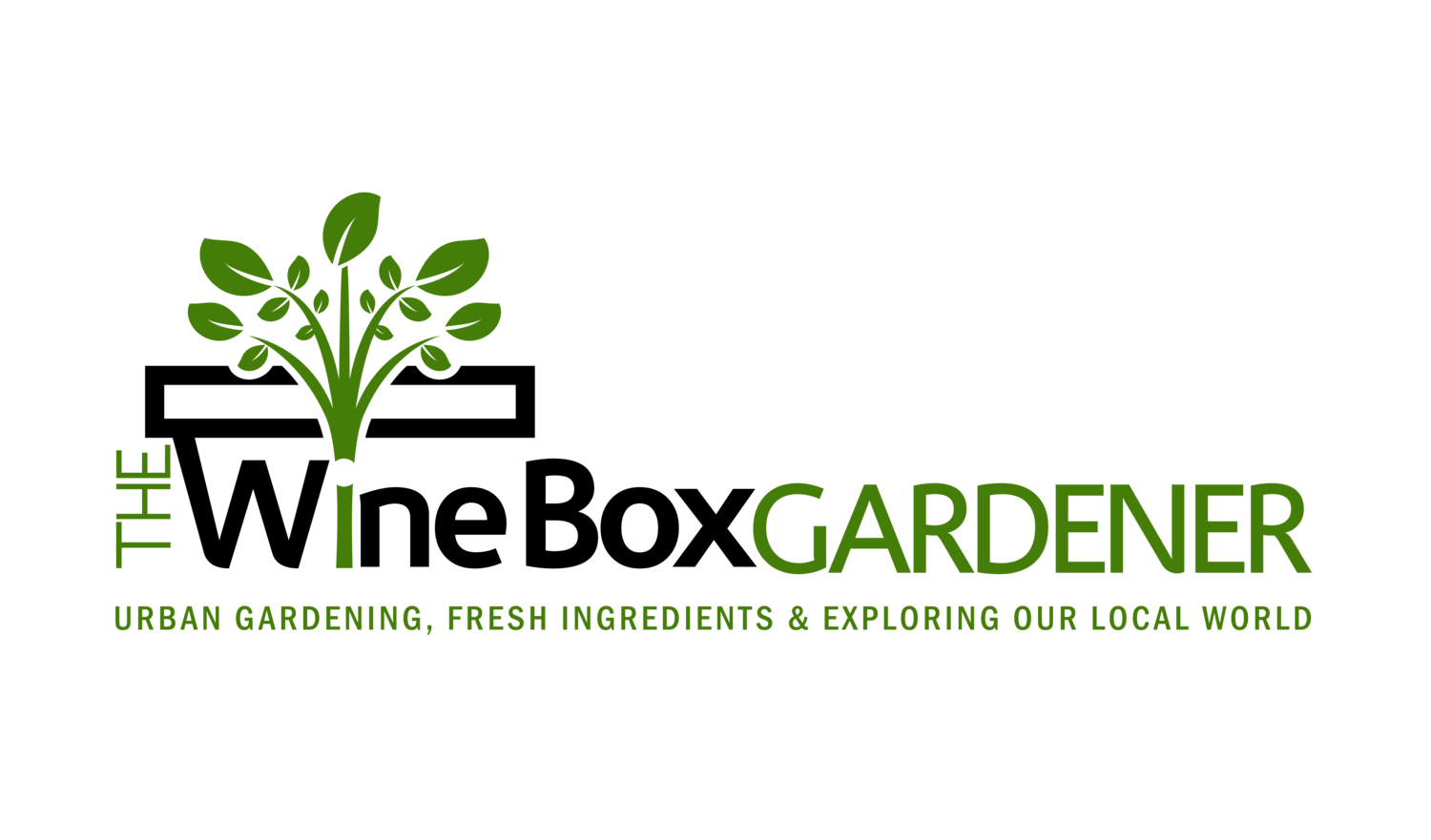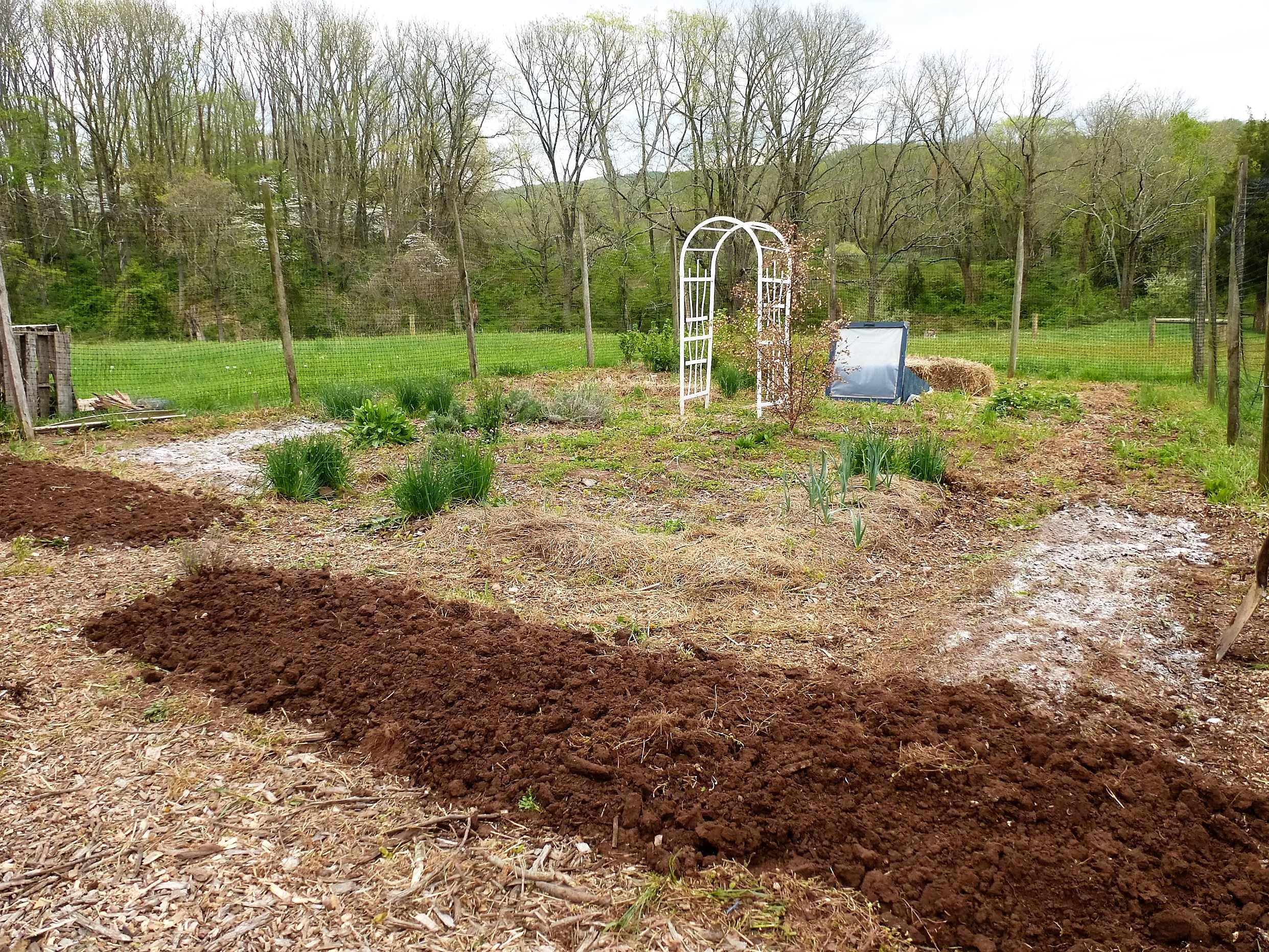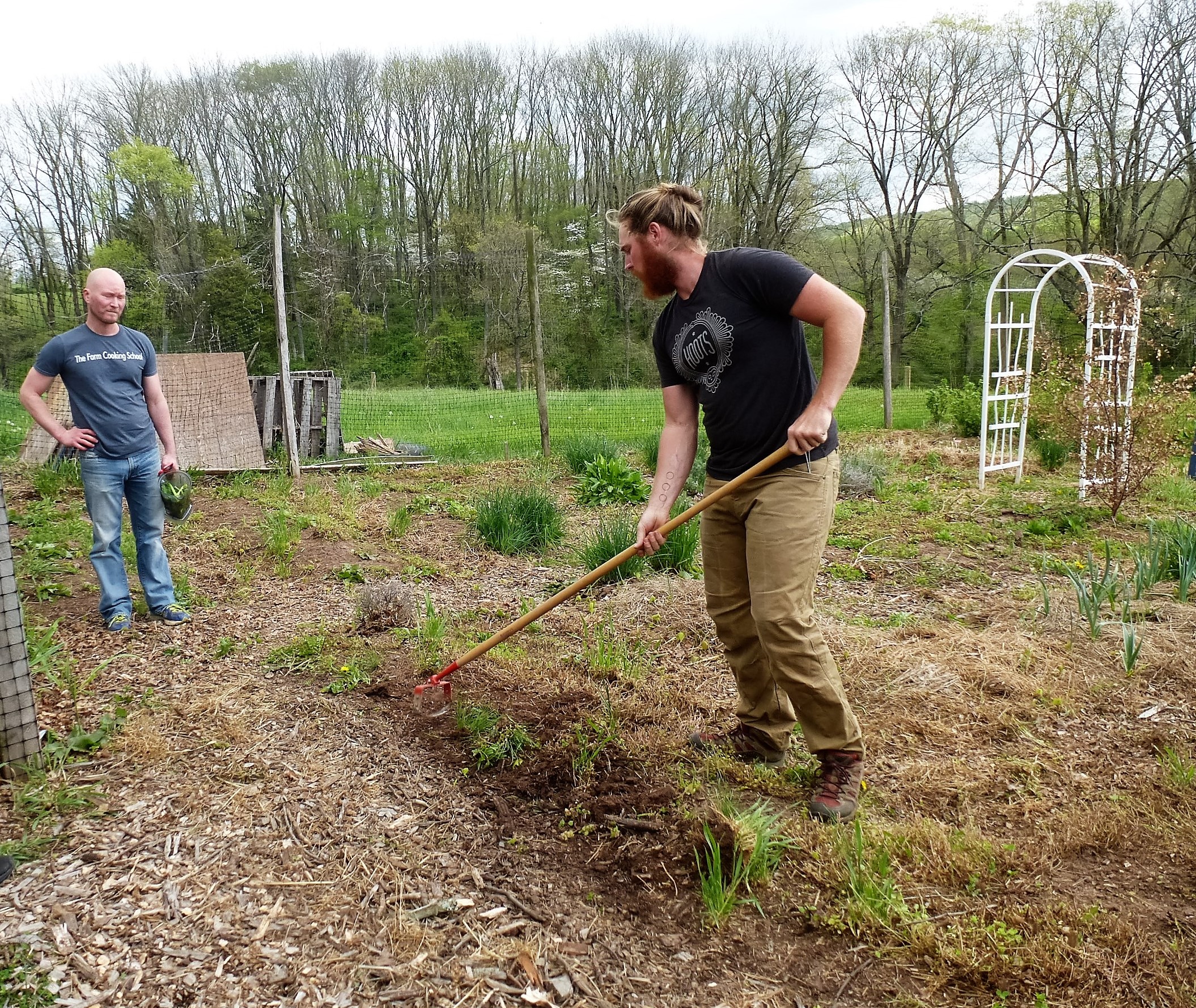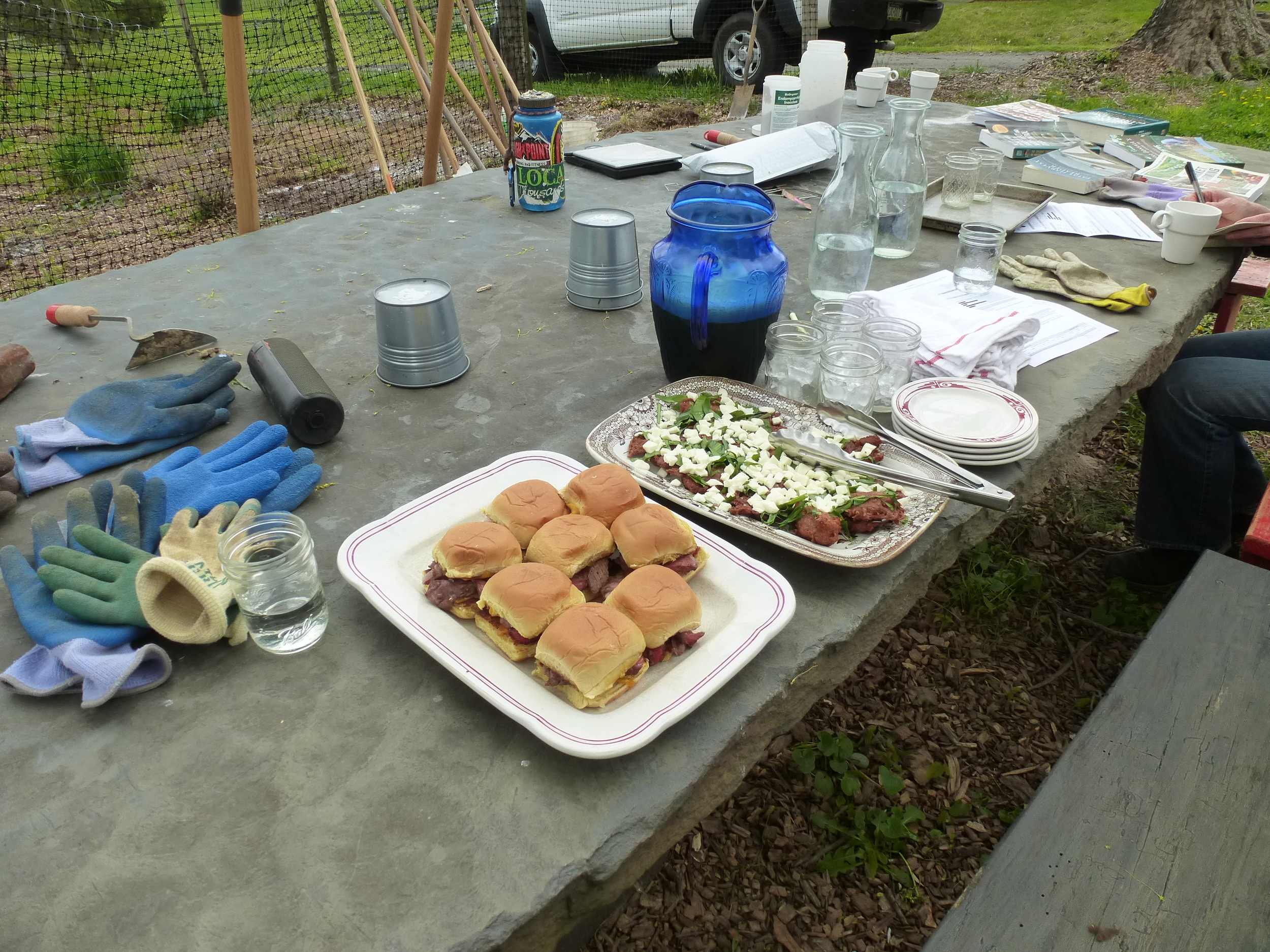Digging in the Dirt at The Farm Cooking School
I know that I should have spent time in my garden this past weekend. It would have been a great time to get my plants and seeds in the dirt, but I couldn't resist the opportunity to spend some time at The Farm Cooking School's Spring Planting Garden Workshop on Saturday. The Farm Cooking School is in Stockton, NJ on the grounds of Tullamore Farms. I went there last year for their Tomatofest session in the kitchen, which was a fun (and tasty) learning experience.
Since this workshop, The Farm Coking School has moved to Roots to River Farm at Gravity Hill, a working organic produce farm - 67 Pleasant Valley Rd, Titusville, NJ 08560, Jamie Sims, who conducted the garden workshop is now also a member of the Roots to River team.
The garden workshop explored:
- Soil nutrition, testing and amendments
- Preparing the soil with "double-digging"
- The basics of crop rotation
The workshop, which was led by Jamie Sims, Farmer/Co-Operator at Locust Light Farm and Kitchen Garden expert who is managing The Farm Cooking School garden, focused on growing veggies in a small space... Right up my alley, right? Heck, I'm a sucker for some good garden knowledge, so I decided to make next weekend my big gardening weekend in The Wine Box Garden and went to the workshop. Needless to say, I have no regrets.
Nurturing the Soil
I've never been the strongest in math and science (I've become more of a "word" gal). But, I think to be a stronger gardener, you have to know at least some of the basics of soil chemistry and how to calculate amendment additions. I've learned quite a bit along the way as I've gardened, but have a ways to go. Jamie was great at breaking it all down for us and I have to say, my "soil senses" got a bit of an awakening.
Soil Testing & Amendments
They had their garden soil tested by the Penn State University Extension. You can take an aggregate soil sample from your garden and send it in for analysis and they'll give you recommendations on what amendments to add. Different states have extensions like this. If you're in NJ, you can even send it into the Rutgers Extension. Here's a bit more about that. With container gardening -- maybe an aggregate wouldn't give me the right recommendations for the whole garden, but there are also soil tests you can buy and do it yourself.
Soil Nutrition
There's a lot to know about the chemistry of soil, but I'll stick to the basics here. You may have seen "NPK" or numbers like, "10-10-10" or "3-4-4" on your bag of organic fertilizer, like Garden Tone. "N" refers to nitrogen, "P" refers to phosphate, and "K" refers to potash or potassium. (If you're wondering where the K comes from in potassium, refer to the periodic table of elements.) A number like, "3-4-4" means that it contains 3% nitrogen, 4% phosphate and 4% potassium. Your soil should have a good balance of these nutrients.
If you are adding compost to the soil as well, you can have that tested too. Whatever soil amendment recommendation you get, be sure to factor the NPK levels of your compost in the mix. For example, the extension recommended they add 10-10-10 to their soil, but they know their compost is about 8-8-8. Instead of adding 10-10-10, we added 3-4-4 because, in combination with the compost NPK levels, that would bring the amendments in total to roughly 10-10-10 (a little higher, but that's ok).
You'll also hear about the "pH" of soil. The pH refers to how acidic/alkaline the soil is. pH aids in a plant's ability to take up nutrients. If your pH is too low, plants may struggle a bit to absorb what they need. Some plants though, like blueberries, actually require a lower level of pH than other plants. In the case of the Cooking School garden, their pH was too low for what they are growing, so we added limestone as an amendment to the soil to help bring up the levels of pH. Although we didn't need to lower the levels at the Cooking School garden, here are a few tips from Rodale's Organic Life on ways to get that pH down if that's your soil issue.
Two additional amendments Jamie introduced were Endomycorrhizal Inoculant and Myco Minerals. Both are useful additives because they add bacteria and minerals that help break down the nutrients in the soil to make them more available to the plants.
Preparing the Soil
The three main steps we took to prepare the beds were:
- Clear the weeds and debris
- Apply amendments
- Double-dig the soil
Myriad tools we used throughout the day
Step 1. Before applying any amendments, we worked on the soil to remove the straw that had been put down for winter and got rid of the weeds. One of the most useful tools we used for this was one I haven't used before, which was the stirrup hoe. This isn't something I'd use for containers, but for beds, it was great. If you're dealing with weeds in your garden beds, invest in one of these. You can see a quick video of it in action here and can see a few other useful tools here. Jamie covered quite a few of them with us. (I wish I had thought to take a video of him covering the different tools.)
Clearing the weeds with the stirrup hoe
Step 2. We took the recommendations from the Penn State Extension and applied amendments as evenly as possible. To apply, just kind of dust them lightly over the beds. You can even take out the flour sifter to spread evenly, but don't worry too much about being exact - this is gardening...we're not making a souffle here. Use the recommendations from your soil test or the packages themselves to calculate how much you'll need per bed.
Applying amendments
Step 3. Double-dig the soil. If you have a bed that has poor soil, this is a great bio-dynamic technique that will help loosen the soil while not making it too fine. Double-digging involves the first step that loosens the soil and moves it forward. Just cut into about 6-10 inches of width and across the bed with a spade, dig in and lift the soil forward. The second step is to get the cultivator out and loosen the layer of soil underneath that is very compact and hard. This is a great alternative to roto-tilling (which can make the soil too fine and in turn will become too compact too quickly). Here's a great video that demonstrates the double-digging technique.
Starting the initial trench for double-digging
We left Jamie with more to do, but this is what we were able to accomplish for the day. (And despite what you see in these pictures, we didn't make Jamie do all the work! We worked along with him. )
Crop Rotation: Fruits, Shoots & Roots
I touched upon this very briefly in my recent post, 5 Steps for Tomato Gardening Success, but if you're using the same land/beds/containers each year with the same soil, it's beneficial to rotate what you grow in the same area. Rotating crops helps maintain good soil nutrition, reduces unwanted pests and disease, and keeps a healthy garden going naturally.
Here's the deal....When plants grow in soil, they take away certain nutrients. Naturally, different plants feed off different nutrients and some, more intensely than others. To maintain healthy plants in the same soil year after year, you should put in plants of different categories - ones that have different soil requirements. Jamie gave us a good way to remember it, and that's with the rotation of "Fruits, Roots & Shoots." Since I've gotten home and researched this a little, some people also throw in "Leaves" or "Legumes" into the mix.
How it Works
- Fruits (e.g., tomatoes, cucumbers, peppers and squash) use lots of the nitrogen in the soil. This is also true of leafy veggies like lettuce, spinach, and broccoli. Through the growing season, these plants will deplete the soil of nitrogen. So, your next planting in that soil shouldn't heavily depend on lots of nitrogen...like root veggies.
- Roots (e.g., carrots, potatoes, onions) don't need as much nitrogen, but they do eat up lots of potassium.
- Shoots/Legumes (e.g., beans, peas) need lots of phosphorous and actually add nitrogen back to the soil.
During and after this rotation, you'll still need to keep on top of soil health and amendments, but this is a natural way to keep plants in the same soil getting what they need year after year.
A Day Well Spent
I am a motivated gardener, but I'm busy with "life" outside the garden. So, it was tempting to just "do the necessary" and forego the workshop so I could check off my "Garden To-Do's." But....opportunity comes when it comes, and sometimes you have to just put learning at the forefront of your endeavors. That's what I did and I'm better for it. I love what The Farm Cooking School is doing in general and so glad to see that they are offering up their resources in the garden for others to learn from. Keep your eye on their calendar as they have another workshop coming up on May 29th and they're looking to add more gardening workshops. They also have some REALLY great cooking courses. They're only about 1 hour from where I am in Maplewood, NJ. If you're near Stockton, NJ....give them a try. (And if it helps to convince you further, Ian made what he called "snacks" for us while we took a break. Ummm...if these are "snacks," you can imagine what you'll be cooking in the kitchen if you go to one of their cooking classes.....)
Beef sliders, fritters with cheese and a refreshing sorrel cooler (from fresh sorrel from the garden).
We thoroughly enjoyed the delicious snack break with Ian Knauer.
Happy Gardening!
A few good books and resources recommended by Jamie Sims











